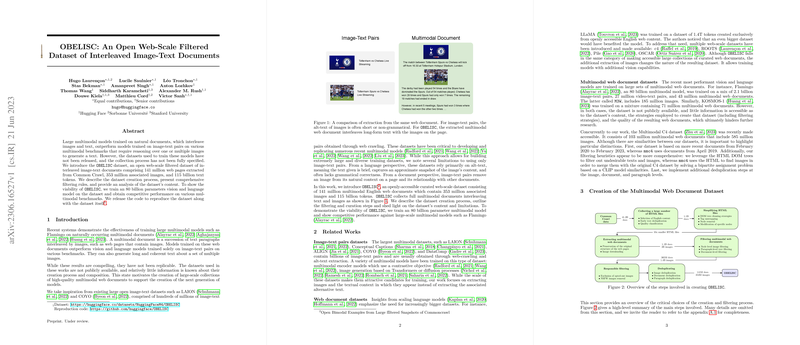An Overview of OBELICS: An Open Web-Scale Filtered Dataset of Interleaved Image-Text Documents
This paper presents the OBELICS dataset, a significant contribution to open-access resources in artificial intelligence research. OBELICS consists of an extensive web-scale collection of interleaved multimodal documents extracted from the Common Crawl, comprising 141 million web pages, 353 million images, and 115 billion text tokens. The dataset is designed to address the limitations of existing datasets by providing a higher quality and publicly available resource for training large-scale multimodal models.
Key Features and Methodology
The distinguishing factor of OBELICS lies in its composition, containing full multimodal documents rather than isolated image-text pairs. This approach aligns with findings that models trained on natural interleaved documents consistently outperform those relying only on image-text pairs across various multimodal benchmarks. The paper describes a comprehensive methodology for creating OBELICS, focusing on retaining document context and applying rigorous filtering rules.
The authors detail the systematic extraction and processing techniques used, such as HTML simplification and explicit deduplication steps at the document, image, and paragraph levels, shielding the dataset from redundancy and low-quality content. Furthermore, the dataset has been filtered to mitigate concerns over data consent and explicit content, integrating measures like the exclusion of opted-out images and NSFW filtering.
Detailed Dataset Analysis
OBELICS is thoroughly analyzed, with the authors presenting detailed statistics demonstrating its scale and uniqueness. For instance, it boasts an 84.3% rate of unique images, illustrating effective deduplication compared to other similar datasets like mmc4. Additionally, the dataset offers a wide array of topics revealed through LDA, indicating its diverse content that spans from politics to entertainment, extending its usability for training robust and versatile AI models.
Moreover, perplexity analysis shows OBELICS having lower average scores compared to other open datasets, suggesting superior text quality more akin to curated corpora such as The Pile. This quality is critical for training high-performance LLMs.
Empirical Validation of Viability
The research includes empirical comparisons between models trained on different data compositions—OBELICS alone, image-text pairs alone, and combinations thereof. Notably, OBELICS demonstrates its utility by providing competitive model performance with fewer training images, thus underlining the efficiency gained through richer multimodal contexts. For instance, in visual question answering tasks, models pretrained on OBELICS outshine their counterparts trained on image-text pairs due to the depth and breadth of understanding fostered by interleaved documents.
Furthermore, the paper introduces IDEFICS, large-scale models demonstrating performances on par with closed datasets-trained models such as Flamingo. IDEFICS models manage to achieve strong benchmarks across various tasks, showcasing OBELICS as a formidable open alternative for the training of large-scale vision-LLMs.
Implications and Future Research
OBELICS holds potential for wide-ranging implications in developing open, reproducible, and transparent AI research. By providing an accessible dataset with detailed creation and filtering documentation, it facilitates the replication and extension of cutting-edge multimodal models without the constraints of proprietary datasets.
Future developments suggested include expanding the dataset with more diverse sources or enhancing the quality through community-driven filters. This trajectory may continue bridging the gap between open-access resources and proprietary datasets in AI, nurturing a more inclusive research landscape.
In conclusion, OBELICS stands as a vital resource for the AI community, aiming to augment the scalability, accessibility, and transparency of multimodal model training, pushing forward both theoretical and practical advancements in AI research.
